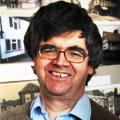The statue of King Alfred in Wantage Market Place is the most well-known point of interest in our town.
It was unveiled on July 14, 1877, by the Prince and Princess of Wales and commissioned by Col Robert Loyd-Lindsay VC.
The sculptor was Count Gleichen who will be the least known person associated with the statue today. Who was he and how did he come to be the sculptor chosen to do the town’s best known landmark?

Count Victor Gleichen was born on December 11, 1833, in Wuttemberg Germany the third son of Ernst 1, Prince of Hohenlohe-Langenburg and was at that time Prince Victor Ferdinand Franz Eugene Gustaf Adolf Constantin Frederich of Hohenlohe-Langenburg. His mother was Princess Feodora of Leiningen, the half-sister of Queen Victoria. Therefore he was closely related to the British Royal Family.
Victor’s early life was spent in Germany until Queen Victoria, hearing of her nephew’s wish to go to sea, suggested to his mother that he come to England and join the Royal Navy.
This was agreed upon and after naturalisation he entered the Royal Navy as a midshipman.
HMS Powerful was his first ship under the command of Sir George Seymour who later became his father-in-law. Victor’s naval career lasted 20 years and took him from America to the Far East and many places in between. One of his many adventures occurred whilst he was in China in 1856. In an open boat under heavy shore fire, Victor was one of nine attempting a landing. The boat received many hits one of which shot away the oars and left two men severely wounded to whom he applied aid. A Lieutenant was then hit and pitched overboard; Victor dived in and hauled him back aboard and dressed his wounds. As the boat came closer to shore the fire became fiercer and accurate and the boat was hit. Grabbing the wounded officer, Victor held onto him until they were picked up. A recommendation for a Victoria Cross to Prince Victor was made but never awarded.

Prince Victor married Laura Seymour in 1861, but under German law the wife in a morganatic marriage could not use the title Princess, so Prince Victor renounced his title and decided to use the family name of Count Gleichen. Illness undermined his health forcing his retirement from the Royal Navy in 1866. Unfortunately he also went bankrupt at this time as well, so what to do with a growing family of four children to support. Sculpture had always been a great interest, so he went to William Theed, the prominent sculptor of the day, for three years tuition and produced pieces of sculpture which he hoped to sell. Queen Victoria allowed him to build a studio in the grounds of St James’s Palace. The commissions started to come in for everything from allegorical pieces to portrait busts.
It was during this period that Sir Robert Loyd-Lindsay VC recalled the Lieutenant he had met during the Crimean War, now a sculptor in his own right. A meeting ensued, a price was agreed (2,000 guineas) and the concept of a statue for Wantage was born. It is believed three models for King Alfred were made before the final work was undertaken. The photos here show King Alfred at the St James’s Palace studio and bringing the block of marble to be worked upon.

It was to be the largest single piece to be produced apart from a beautiful allegorical figure he made for his mother’s grave in Germany. Other work by Count Gleichen includes a statue of Queen Victoria at Royal Holloway College, the statue of Frederick Gye at the Royal Opera House in London and a bust of Admiral of the Fleet Sir Henry Keppel (with whom the artist served) at the Institute of Directors also in London.
Count Gleichen died of throat cancer on December 31, 1891.






Comments: Our rules
We want our comments to be a lively and valuable part of our community - a place where readers can debate and engage with the most important local issues. The ability to comment on our stories is a privilege, not a right, however, and that privilege may be withdrawn if it is abused or misused.
Please report any comments that break our rules.
Read the rules here